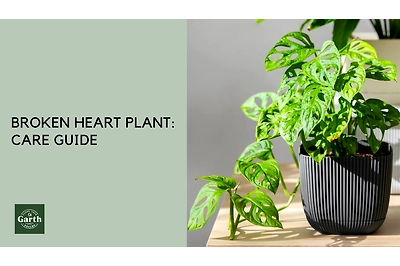Philodendron Pink Princess: A Complete Care Guide From Beginner to Expert
- 11 Feb, 2025

Philodendron Pink Princess has become a coveted houseplant because of its lovely dark green leaves, which are variegated with dramatic pink splashes and streaks. Add a touch of elegance to any room with this regal beauty, but be warned it does have stringent care. This guide will help you learn how to care for it from the basics, troubleshoot common problems, and ensure that your Pink Princess thrives.
How to Grow and Maintain a Healthy Pink Princess
1. Best Soil and Potting Mix for Philodendrons
The ideal soil for Pink Princess Philodendrons is draining but moisture-retaining. A well-balanced mix of coco peat, vermicompost, soil, and sand is ideal for healthy plant growth. In addition to avoiding root rot, this combination guarantees adequate aeration, drainage, and nutrient retention. Dense garden soil by itself should not be used since it can retain too much moisture and damage the roots.

2. How to Induce Further Pink Variation
The variable pink portions of the pink princesses are the result of genetic mutations. You can't control the precise pattern, but the best care—that is, bright, indirect light—encourages more pink variegation. Too little light will be more green than pink.

3. Watering Tips for a Thriving Pink Princess:
Water your Philodendron Pink Princess when you find that the top inch of soil feels dry. This is usually the number one cause of trouble. Make sure that your pot has drainage holes in it to prevent waterlogging. Best time to water plants is in morning. Generally, you will water more in the warm months and less in the cool months. Garth Greens recommends using self-watering pots to ensure your Pink Princess stays perfectly hydrated. So If you're away from home, your plant will still receive the moisture it needs to thrive, keeping its vibrant pink and green leaves healthy.
4. Best Conditions for Lighting:
The pink princesses love bright, indirect sunlight. Scorches their leaves so much. Place it near a window in indirect, filtered sunlight. It can be put under a grow light quality. Lack of light will mean that variegation will not be as vibrant and leggy growth too.

5. Best Pots and Containers:
Select a pot with suitable drainage. Terracotta pots are a good option because they allow the most airflow. You will have to report your Pink Princess every year or after 2 years, and you will need to select a pot that is a little bigger than its current one. If you are also looking for the best pots and containers, visit Garth at reasonable prices.

6. How to Fertilize Your Philodendron Pink Princess:
For your Philodendron Pink Princess to grow strongly and have colorfully decorated leaves, you must fertilize it. During the growing season (spring and summer), apply a half-strength, balanced, water-soluble fertilizer once a month. During the fall and winter periods, reduce the amount of fertilizer you apply. For that boost, use fertilizer that contains equal amounts of potassium, phosphorus, and nitrogen.
The Philodendron erubescens, also known as the Pink Princess Philodendron, is a stunning and highly sought-after houseplant with heart-shaped leaves featuring dramatic pink variegation. To ensure proper Pink Princess Philodendron care, use well-draining soil that retains moisture without becoming waterlogged.
When propagating, stem cuttings are the most effective method. Simply snip a healthy cutting with a node and place it in water or soil until roots develop. To care for your Pink Princess, provide it with bright indirect light, consistent watering, and occasional fertilization. With the right attention, this exquisite plant will flourish and bring a unique touch of elegance to your indoor space.
Problems and Solutions
1. Common Problems and Solutions:
- Discoloration of Leaves: Either excess water, neglect for a longer duration, or lack of essential nutrients. Change watering habits and add fertilizer if needed.
- Brown Tips on Leaves: drought or frequent watering in turns. Humidify it more and water it consistently.
- Long and Lanky: light deficiency. Keep the plants in a place where there is more light. Give wounds to plants by overwatering. Report the plant in new media and permit better drainage.
2. Why Is My Philodendron Losing Its Pink Color?
The most common cause for the pink-tinged leaves of a Pink Princess turning green is insufficient light. Place the plant in a spot where it will receive bright but indirect light. Age also has some effect because variegation may fade a bit with time and a factor like stress, due to poor watering and fluctuations in temperatures.
3. Prevention of Pests and Diseases:
Pests: The common pests are spider mites, mealybugs, and aphids. Check plants at least twice a week and wash off all the pests using any insecticidal soap or neem oil. Diseases: The most common disease is root rot, and it is caused by overwatering. It prevents it by using proper drainage and making sure that the soil gets a little dry between watering sessions.
Conclusion
Naturally, the Philodendron Pink Princess is a mesmerizing houseplant. Its a plant with green and pink leaves. Although it requires a bit more effort than some other plants, the reward is utterly amazing. Therefore, with good care, you can enjoy the beautiful loveliness of this rare gem and add that pinch of pink enchanting magic into the walls of your home. Are you thinking of buying a Pink Princess philodendron? But you don't know if you're ready to be its perfect plant parent? Don't worry! Here at GarthGreens, we're providing you with all the information needed to give your plant the best care possible!


